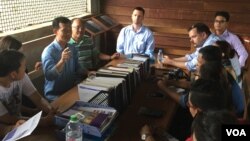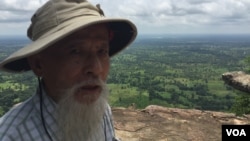Researchers and survivors of the Khmer Rouge regime have called for a new generation of Cambodians to seek a deeper understanding of their history following a visit to the former regime stronghold of Anlong Veng.
The group visited the Anlong Veng Peace Center, which opened in 2014, in early September - the final holdout of regime leaders Pol Pot and Ta Mok.
Hoy Sochivanny, president of NGO Positive Change for Cambodia, told VOA Khmer while taking a walk near the center that such initiatives could ensure that Cambodians do not repeat the mistakes of the past.
“The remembrance of the Pol Pot regime and the killing during the regime is the memory of how Cambodians suffered from this regime and how the next generation can learn or let the next generation of Cambodians build inner peace,” she said.
“Building peace from the heart and feeling among them and preventing them from having hot tempers and minds and a violent heart between groups ... war was a huge dispute that we learned in the past.”
Sochivanny, who serves as a peace ambassador to other Asian countries, said although it took a long time for the center in Anlong Veng to be established, it was not too late for the next generation to benefit from studying the reconciliation process.
The settlement of Anlong Veng was recorded by French cartographers as early as 1907 while they were demarcating the modern Cambodian state, according to a 2014 book, The Anlong Veng Community, authored by Dy Khamboly and Christopher Dearing.
The region has historically shifted between Thai and Cambodian control until the arrival of the French Protectorate and the formation of a political movement led by then Prince Norodom Sihanouk in 1955. Created out of the province of Siem Reap, Anlong Veng was occupied by the Khmer Rouge and suffered under the grim agrarian administration that oversaw purges, arrests, and mass killings.
On June 9, 1997, the execution of Son Sen, previously a party stalwart, marked the beginning of the end of the Khmer Rouge movement. After Sen’s execution, factional disputes erupted and eventually led to the arrest and trial of Pol Pot, in July of that year. By 1998, the remaining Khmer Rouge forces had been integrated into government forces following a series of negotiations.
Ly Sok Kheang, director of the Anlong Veng Peace Center, told visitors that peace-building requires time and planning. “It’s about education and we use history to reflect on. When people learn about their history, people will not always repeat the same footsteps that we took in the past,” he said.
“So that’s why we try to influence and show the younger generation, and our leaders as well, when you commit a crime, there’s going to be a trial in the future. You know in our country, without trials, people will not understand,” he added.
The peace center, an initiative of the Documentation Center of Cambodia (DC-Cam), is housed in the former headquarters of Ta Mok’s faction, perched high atop the Dangrek Mountains near the Thai border. As well as serving as an educational resource, the center is working to preserve 14 historical sites in Anlong Veng district.
“Now, many students come every day,” says Sok Kheang. “At first we ask them to meet the people in Anlong Veng region. They made their interviews into articles that have been published in [local newspaper] Rasmei Kampuchea and Seeking the Truth magazine for others to understand the history of each person who went through the Khmer Rouge.”
“When they start to understand, there will be a push for mutual understanding, tolerance, and reconciliation.”
Born in 1926 in Takeo province, Ta Mok saw Anlong Veng as its own country, according to Khamboly and Dearing, who described in their book how he organized the villages and named them according to nearby natural resources, such as Tuol Tbeng, named after a local timber plentiful in the area. Ta Mok died of disease in 2016.
Pou Sovachana, deputy director of the Cambodian Institute for Cooperation and Peace (CICP), told VOA Khmer that if politicians saw continuing to learn from this history as important, “real peace can surely take root when we know how to ... build real peace and harmony.”
Lao Monghay, a veteran political and social analyst who accompanied the group, said visits to the center could help bridge the gap between young Cambodians and those still nostalgic about the days of the Khmer Rouge.
“Our ideas can be different from others whose ideas could be different from ours, but the idea that relies on truth could be in everybody’s joint interest. We must listen to such ideas,” he said.
Like many sleepy Cambodian villages and towns, life in Anlong Veng still resonates with an ethos of collectivism and a deference to independent living. Residents value the space that comes with living on the periphery of Cambodian society and there is an air of pride in the community’s ability to look after themselves.
Sok Kheang, the peace center director, said that the center’s role goes far beyond the preservation of history, as it is also working on restoring the local environment, which has been devastated by deforestation and surging development.











